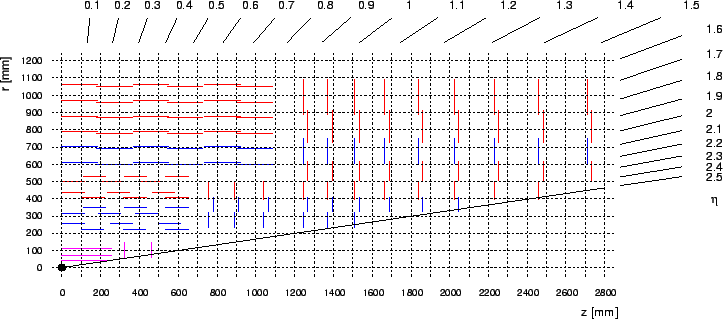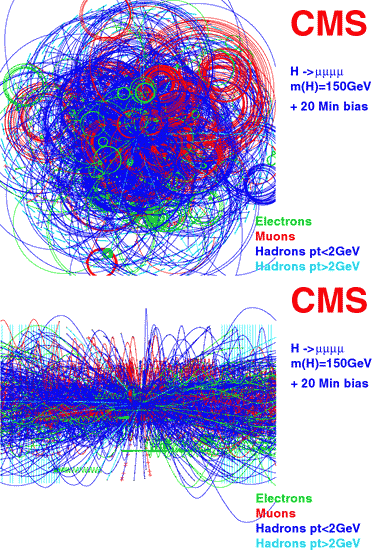



Next: Pixel Detector
Up: disshtml
Previous: Radiation Damage
Contents
CMS Tracker System
The CMS Tracker is completely made of silicon detectors, which are the best choice
for tracking purposes in the LHC environment. In present and past experiments,
large-volume gas detectors were a (cheaper) alternative to silicon, but they have
a slower response time, so that the LHC timing requirements do not allow their usage.
The tracker consists of a central (barrel) part with three pixel and ten strip layers
and the disk and endcap sections with two pixel and twelve strip layers [38].
A cross-section of one
quadrant is shown in fig. ![[*]](crossref.gif) .
The pixel layers in barrel and endcap parts are shown in purple, while the strip
layers are drawn in red (single-sided detector modules) and blue (double-sided detector module).
The double-sided modules are made of two single-sided detectors mounted back to back with
a strip inclination of
.
The pixel layers in barrel and endcap parts are shown in purple, while the strip
layers are drawn in red (single-sided detector modules) and blue (double-sided detector module).
The double-sided modules are made of two single-sided detectors mounted back to back with
a strip inclination of  against each other. Thus, these ``stereo'' modules
deliver two-dimensional hit positions.
against each other. Thus, these ``stereo'' modules
deliver two-dimensional hit positions.
Figure:
One quarter of the CMS Tracker layout. Pixel detector
layers are shown in purple, while strip detectors are in red (single-sided)
and blue (double-sided). The origin denotes the collision point and the numbers on top and
right give the angle in units of pseudorapidity  , which is a function of radius
, which is a function of radius  and the distance
and the distance  along the beam axis (eq.
along the beam axis (eq. ![[*]](crossref.gif) , p.
, p. ![[*]](crossref.gif) ).
).
 |
The number of detector layers is a tradeoff between tracking efficiency, material
budget and cost. On one hand, the number of hits increase with the number of layers penetrated,
which makes the track reconstruction easier. On the other hand, the amount
of material within the tracker should be kept as low as possible, because
multiple scattering, which spoils the tracks, is proportional to the amount of material
traversed by the particles. An even tougher constraint is the cost of the tracker,
which reduces the number of layers to an affordable design.
Simulations on various tracker configurations finally led to the
geometry shown in fig. ![[*]](crossref.gif) .
.
Figure:
Simulated CMS event in  (top) and
(top) and  (bottom)
projections. A Higgs with a mass of
(bottom)
projections. A Higgs with a mass of  decays into four muons.
It is difficult to spot the muons in the tracker, but they are clearly identified
in the muon detector, which is the outermost subsystem (see section
decays into four muons.
It is difficult to spot the muons in the tracker, but they are clearly identified
in the muon detector, which is the outermost subsystem (see section ![[*]](crossref.gif) , p.
, p. ![[*]](crossref.gif) ).
).
 |
In an average event, about 750 charged particles arise from each bunch crossing,
which produce a few thousand hits in the tracker.
Fig. ![[*]](crossref.gif) shows a simulated CMS event where a Higgs boson with a mass of
shows a simulated CMS event where a Higgs boson with a mass of
 decays into four muons in two projections. Physicists claim that they can extract
and identify single particles out of the detector data. In fact this seems possible when
keeping in mind that the tracker granularity is very small and thus the occupancy
is still reasonably low, while fig.
decays into four muons in two projections. Physicists claim that they can extract
and identify single particles out of the detector data. In fact this seems possible when
keeping in mind that the tracker granularity is very small and thus the occupancy
is still reasonably low, while fig. ![[*]](crossref.gif) only shows two-dimensional
projections. Most of the particles are of low momentum (below
only shows two-dimensional
projections. Most of the particles are of low momentum (below  ) and
thus of no interest with respect to the physics goals. Due to the high magnetic
field of
) and
thus of no interest with respect to the physics goals. Due to the high magnetic
field of  in the tracker, their tracks are
bent with a small radius (according to eq.
in the tracker, their tracks are
bent with a small radius (according to eq. ![[*]](crossref.gif) ) such that many
of them will not be able to exit the tracker at all. The
helix traces of these particles are displayed as circles or sine curves in the
shown projections.
) such that many
of them will not be able to exit the tracker at all. The
helix traces of these particles are displayed as circles or sine curves in the
shown projections.
The simplest approach to track reconstruction from a set of hit points is to start with
a pixel hit in the innermost layer
and project a cone onto the next layer in radial direction. If no hit can be found there, the
starting point was either noise or a particle of very low energy which get stuck or was
deflected by multiple scattering, so the original hit can be discarded.
Otherwise, the procedure can be repeated until
finally the full track through all planes is found. Of course, the procedure is much more
complicated in reality: Dead or inefficient regions have to be taken into account (e.g., by
skipping a layer) and the magnetic field bends the tracks depending on the particle
momentum. Since there is a lot of low-momentum background in the innermost part of the tracker,
a more advanced concept starts its track search from the outside.
With this approach, a preselection of interesting tracks is provided by the first-level trigger,
which is obtained from calorimeter and muon detector data.
The operating temperature of the CMS tracker will be
 . This is
required by the silicon sensors, which suffer from radiation damage. Defects are
``frozen'' so they can not gradually decrease the detector quality, as discussed in
section
. This is
required by the silicon sensors, which suffer from radiation damage. Defects are
``frozen'' so they can not gradually decrease the detector quality, as discussed in
section ![[*]](crossref.gif) , p.
, p. ![[*]](crossref.gif) .
.
Subsections




Next: Pixel Detector
Up: disshtml
Previous: Radiation Damage
Contents
Markus Friedl
2001-07-14
![[*]](crossref.gif) .
The pixel layers in barrel and endcap parts are shown in purple, while the strip
layers are drawn in red (single-sided detector modules) and blue (double-sided detector module).
The double-sided modules are made of two single-sided detectors mounted back to back with
a strip inclination of
.
The pixel layers in barrel and endcap parts are shown in purple, while the strip
layers are drawn in red (single-sided detector modules) and blue (double-sided detector module).
The double-sided modules are made of two single-sided detectors mounted back to back with
a strip inclination of 
